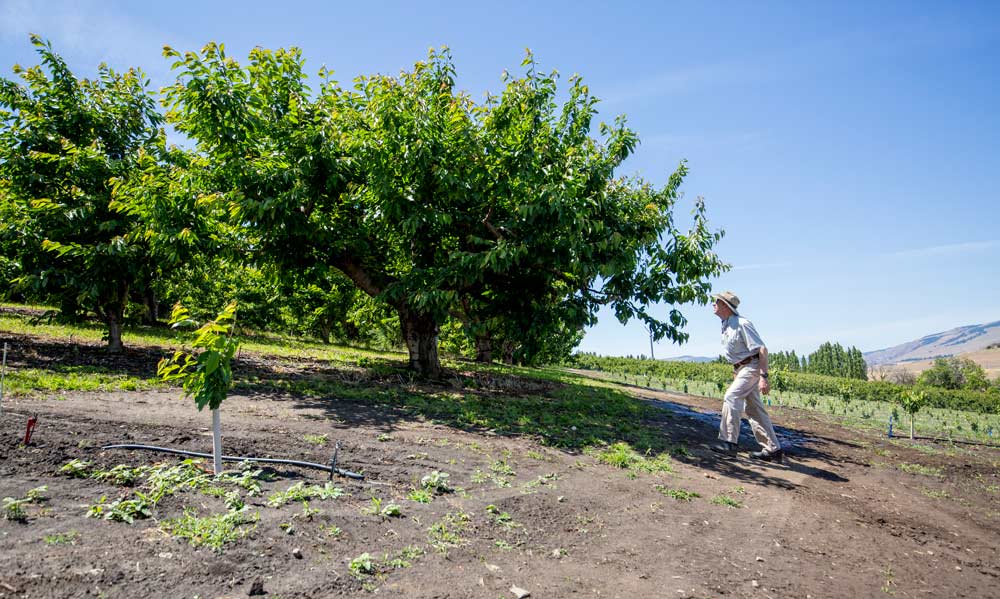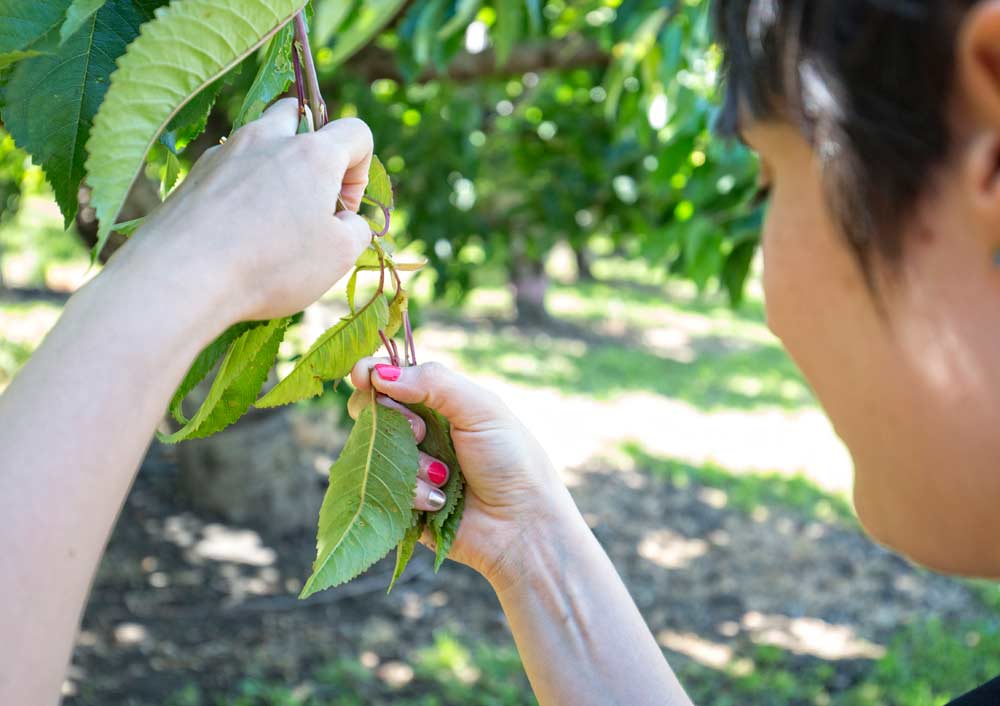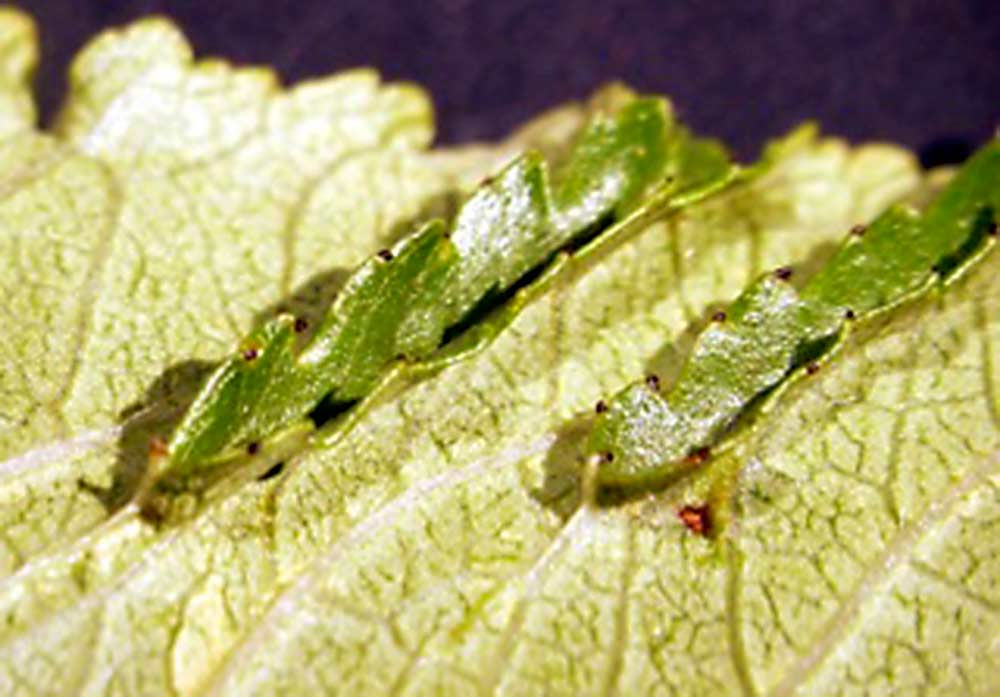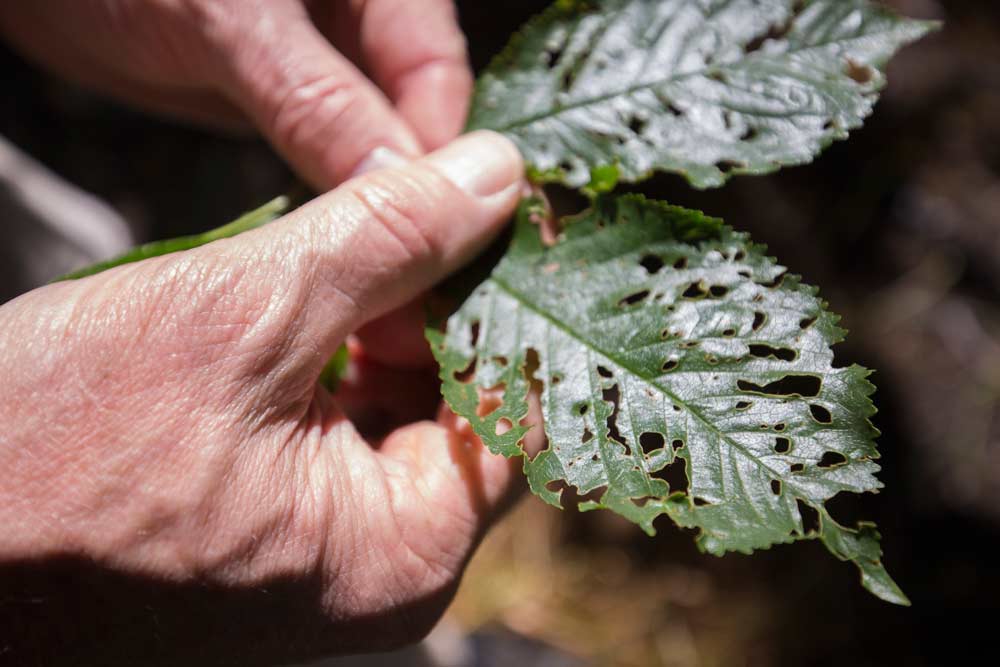
Plant pathologist Jay W. Pscheidt from Oregon State University searches for potential diseases in a cherry orchard near The Dalles, Oregon, in May 2016. (TJ Mullinax/Good Fruit Grower)
A survey of cherry viruses in Oregon has turned up none that are new to the Pacific Northwest, which is a good thing. However, at least two new viruses, and possibly a third, have been detected in Oregon for the first time — and two of the three could have a significant impact on cherry production if not controlled.
Oregon State University professor and Extension plant pathology specialist Jay W. Pscheidt and graduate student Lauri Lutes spent the first year of a two-year project combing the historical records for occurrences of cherry diseases in Oregon and working with cooperators to investigate and sample orchards in the Willamette Valley, Hood River, The Dalles and Umpqua regions.
The effort is intended to give growers a better understanding of what’s hidden in their orchards. “A lot of times, viruses don’t show themselves unless or until a tree has two or three,” Pscheidt said.
Because little cherry disease is such a concern to growers, Pscheidt said the researchers were often guided to orchards with “small cherries.” Three pathogens are associated with little cherry disease: Western X, little cherry virus strain 1, and little cherry virus strain 2.
None of the orchards the researchers sampled had symptoms that were suspected of having the disease, and specifically, none were positive for little cherry virus 2.
However, one cooperating fieldman collected samples for a grower in The Dalles. The trees tested positive for little cherry virus 2 — marking the first known report of the virus in Oregon — and were removed from the orchard.

Lauri Lutes, an Oregon State University graduate student, picks several samples of cherry leaves to determine if the tree has little cherry disease in an older cherry block in The Dalles, Oregon last year. The leaves did not have any symptoms of little cherry disease but could have contained the virus. (TJ Mullinax/Good Fruit Grower)
Drew Hubbard, the crop consultant who collected the samples, took Pscheidt and Lutes to the Bing orchard last summer — a mature block of trees on Mazzard rootstock — to collect samples from neighboring trees. “Researchers seem to think mealybug is spreading it, but we never see mealybug here,” Hubbard said, pointing to the orchard. “So how is it spreading, and how did it get here in the first place?”
Pscheidt pointed to mottling on the leaves of other trees in the orchard, which can be indicative of some viruses; however, the neighboring trees ultimately tested negative for little cherry.
Several orchards, also in The Dalles area, had trees with symptoms that were consistent with Cherry leaf roll virus and tested positive twice and by two labs for the virus. “The last part of confirmation is doing a PCR test in-house, but that’s trying to go from 90 percent to 99 percent confirmation,” Pscheidt said. “We’re pretty sure (the disease is) here.
For little cherry disease (or X-Disease), growers should be looking for trees that have small and poorly ripened fruit that tastes bad.
“Those were the two biggies that we found and that growers need to worry about. We found lots of other viruses, but none that rate high on the action scale.”
The researchers also compared published literature to a review of cherry samples sent into OSU’s Plant Clinic from 1956 to present and discovered several unpublished virus reports, including a report of Tobacco ringspot virus in the Grande Ronde Valley — a first for Oregon.

A number of viruses, including some more troubling ones such as cherry leafroll virus, can show symptoms of enations, where an epidermal outgrowth looks like the top of the leaf pops out through the back or underside of a leaf. (Courtesy of Jay W. Pscheidt, OSU)
For Cherry leafroll virus, growers should be looking for trees that are rapidly declining; often, they are co-infected with several other viruses.
Growers also should look for a symptom called “enations,” where an epidermal outgrowth looks like the top of the leaf pops out through the back or underside of a leaf. A number of viruses can show enations, Pscheidt said, and “some of the bad ones will display this symptom.”
Cherries are susceptible to a couple of dozen different viruses. Putting that into perspective for growers — what requires immediate action, what doesn’t — can be difficult, he said. So, the researchers are developing a grower action rating system: For example, a grower in The Dalles who has nearly all Bing cherries planted might have five or six viruses to watch for and worry about.

This leaf sample pulled by OSU plant pathologist Jay W. Pscheidt exhibits symptoms of Prunus necrotic ring spot virus. Pscheidt says this symptom is referred to as “shothole” and is common. (Note, this is different than the fungal disease called shothole.) (TJ Mullinax/Good Fruit Grower)
“The idea was to give growers a more clear plan,” he said. “If a virus doesn’t have any symptoms, it’s a zero. It doesn’t require action.” However, the quarantined Plum pox virus, also known as Sharka in Europe and since found in a few places in eastern North America, “that’s a 10 on the scale.”
The Oregon Sweet Cherry Commission provided nearly $35,000 to fund this research project, which continues for another year. In year two, the researchers will expand their efforts to Oregon’s Rogue Valley, Grande Ronde Valley and Milton-Freewater area. •
– by Shannon Dininny






Leave A Comment